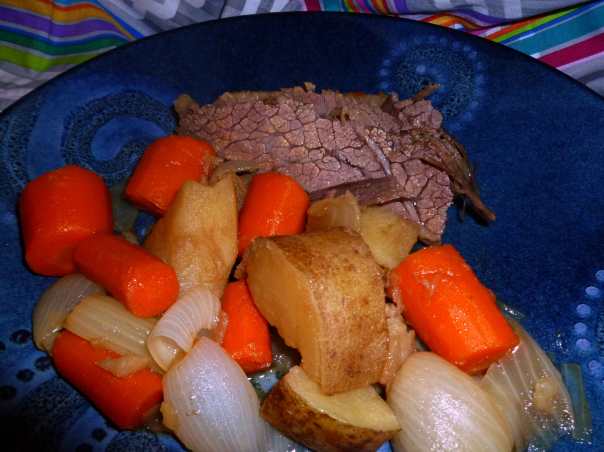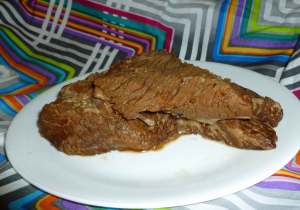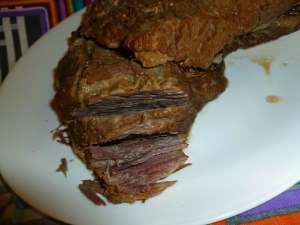
You may remember that we posted a Stout Braised Corned Beef and Cabbage recipe way back in the depths of time. Well, that was in the time before my wheat and corn allergies were diagnosed. At the time, since Mary Kate had issues with gluten, and a lot of our readers are gluten-free, I had put in the modifications needed to make it gluten-free. But once my corn allergy hit, I couldn’t find a safe brand of corned beef that I could buy, because of the dextrose, sodium erythorbate, and other corn ingredients that tend to show up in commercial versions. A while ago, I came across a beef brisket while shopping, and it occurred to me that maybe I could research how to make corned beef, just like I had for learning to cure bacon. Worst case scenario, I’d cook it as brisket if it didn’t work. So I bought it, but I didn’t have time to deal, so I threw it in the freezer. During my most recent “vacation” otherwise known as “food prep week”, I finally decided that it was time. So I looked at recipes from Alton Brown on the Food Network and the Wellness Mama, and modified and added things based on my other research.
I prepared the brine, then I brined the brisket for 10 days, and cooked it according to my original recipe, but using the gluten free tweaks, and without cabbage, because I forgot to buy any. And it was corned beef, and it was good. Even my husband (no food allergies) said it was good. So I’m sharing.
Just a note, this takes a long time. And it’s probably best to do the brine the day before you’re actually going to start marinating, because it has to be completely chilled. Also, be aware that it’s not the right color because we’re not adding curing salt or saltpeter, but it still tastes right.


Cure your own Corned Beef
- 2 quarts of water
- 1 cup of kosher salt
- 1/2 cup of brown sugar
- 1 cinnamon stick, broken into pieces (I used a zip top bag and a rolling pin and smacked it a couple of times)
- 1/2 Tablespoon of brown mustard seeds
- 1/2 Tablespoon of yellow mustard seeds
- 1 Tablespoon of whole black peppercorns
- 8 whole cloves
- 8 whole allspice berries
- 2 bay leaves, broken into bits
- 1/2 teaspoon of ground ginger or 1/2 Tablespoon of crystallized ginger (whichever you have on hand)
- 2 pounds of ice
- 1 cup of fresh celery puree (Take 5-7 stalks of celery and put them through a food processor or blender until they are pureed)
- 1/4 cup of juice from sauerkraut made from red cabbage (optional – just an attempt to get the correct color since I’m not using curing salt)
- 1 – 2 1/2 gallon zip top plastic bag (They have these now! They are brilliant for marinating and knitting projects!)
- 1 – 4 to 5 pound beef brisket
In a large stockpot, add the water, salt, sugar, cinnamon, both kinds of mustard seeds, black peppercorns, cloves, allspice berries, bay leaves, and ginger, and mix to combine. Bring to a boil over high heat until salt and the sugar have dissolved completely. Remove the stockpot from the heat, and add the ice. Stir the mixture until the ice has melted. Put the brine in the fridge until it has completely chilled. And I mean it, completely chilled, so that could take several hours or it might even be the next day.
Once the brine is completely chilled, mix in the celery puree and the sauerkraut juice. Place the brisket in the 2 1/2 gallon zip top plastic bag and add the brine mixture to the bag. Push as much of the air out of the bag as you can and seal it. Place the zip top bag in a container that allows it to lay flat and put it in the fridge for 10 days. You want to check it daily to make sure that the brisket is completely submerged and to flip the bag to stir the brine. After 10 days, remove the brisket from the brine and rinse it off using cold water. Discard your brine, it can’t be used again. Now you have corned beef brisket to cook as described in our original Stout Braised Corned Beef and Cabbage recipe, or to cook it how you normally cook corned beef.
Enjoy!
